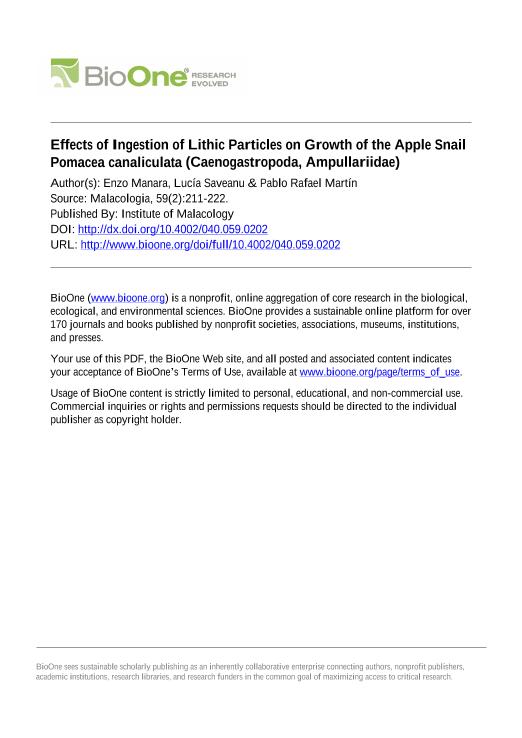Mostrar el registro sencillo del ítem
dc.contributor.author
Manara, Enzo

dc.contributor.author
Saveanu, Lucía

dc.contributor.author
Martín, Pablo Rafael

dc.date.available
2018-04-18T13:35:49Z
dc.date.issued
2016-12
dc.identifier.citation
Manara, Enzo; Saveanu, Lucía; Martín, Pablo Rafael; Effects of Ingestion of Lithic Particles on Growth of the Apple Snail Pomacea canaliculata (Caenogastropoda, Ampullariidae); Institute of Malacology; Malacologia; 59; 2; 12-2016; 211-222
dc.identifier.issn
0076-2997
dc.identifier.uri
http://hdl.handle.net/11336/42414
dc.description.abstract
Lithic particles are a common feature in the digestive tract of freshwater snails. Their role in the digestive processes has been demonstrated in some microphytophagous and detritivorous species, as they enhance growth, assimilation and reproduction. It has been suggested that they could have the same function in Pomacea canaliculata, a macrophytophagous apple snail with powerful jaws and radula, a strongly muscular and cuticularized gizzard and high levels of enzymatic activity. Our aims were to investigate the occurrence of lithic elements in the digestive tract of P. canaliculata snails from natural populations through the analyses of digestive contents, as well as the effect of size and availability of lithic particles on growth and growth efficiency through laboratory experiments. Lithic particles are very common in the digestive tract of P. canaliculata from natural populations and from laboratory aquaria if they are available in the immediate environment. Such particles are not retained or concentrated differentially in the stomach and they are apparently totally lost in less than four weeks if the supply is interrupted. The frequency of plant material and lithic particles increases from mouth to anus indicating that the retention time increases in the same way. Sand and plant material frequently co-occur in the intestine and in the stomach indicating that both are ingested together. Ground marble had negative effects on the growth of P. canaliculata probably due to the sharp edges and pointed ends of these particles. The availability of natural lithic particles (sand) had a positive effect on growth and also a synergic interaction with the availability of food. The growth efficiency was 25.2% higher when sand was available than when it was absent. These effects were more marked in juvenile females than in juvenile males. Our results indicate that growth rates may be underestimated under laboratory conditions if lithic particles are not supplied regularly and that their presence should be standardized to allow reliable comparisons between studies. Our results also indicate that the effects of food availability and plant palatability on the growth of P. canaliculata may be modulated by the presence of lithic particles and this may in turn affect the outcome of interactions between apple snails, other snails and macrophytes.
dc.format
application/pdf
dc.language.iso
eng
dc.publisher
Institute of Malacology

dc.rights
info:eu-repo/semantics/openAccess
dc.rights.uri
https://creativecommons.org/licenses/by-nc-sa/2.5/ar/
dc.subject
Invader
dc.subject
Feeding
dc.subject
Digestion
dc.subject
Trophic Ecology
dc.subject
Growth Efficiency
dc.subject.classification
Otras Ciencias Biológicas

dc.subject.classification
Ciencias Biológicas

dc.subject.classification
CIENCIAS NATURALES Y EXACTAS

dc.title
Effects of Ingestion of Lithic Particles on Growth of the Apple Snail Pomacea canaliculata (Caenogastropoda, Ampullariidae)
dc.type
info:eu-repo/semantics/article
dc.type
info:ar-repo/semantics/artículo
dc.type
info:eu-repo/semantics/publishedVersion
dc.date.updated
2018-03-28T16:58:42Z
dc.journal.volume
59
dc.journal.number
2
dc.journal.pagination
211-222
dc.journal.pais
Estados Unidos

dc.journal.ciudad
Philadelphia
dc.description.fil
Fil: Manara, Enzo. Consejo Nacional de Investigaciones Científicas y Técnicas. Centro Científico Tecnológico Conicet - Bahía Blanca. Instituto de Ciencias Biológicas y Biomédicas del Sur. Universidad Nacional del Sur. Departamento de Biología, Bioquímica y Farmacia. Instituto de Ciencias Biológicas y Biomédicas del Sur; Argentina
dc.description.fil
Fil: Saveanu, Lucía. Consejo Nacional de Investigaciones Científicas y Técnicas. Centro Científico Tecnológico Conicet - Bahía Blanca. Instituto de Ciencias Biológicas y Biomédicas del Sur. Universidad Nacional del Sur. Departamento de Biología, Bioquímica y Farmacia. Instituto de Ciencias Biológicas y Biomédicas del Sur; Argentina
dc.description.fil
Fil: Martín, Pablo Rafael. Consejo Nacional de Investigaciones Científicas y Técnicas. Centro Científico Tecnológico Conicet - Bahía Blanca. Instituto de Ciencias Biológicas y Biomédicas del Sur. Universidad Nacional del Sur. Departamento de Biología, Bioquímica y Farmacia. Instituto de Ciencias Biológicas y Biomédicas del Sur; Argentina
dc.journal.title
Malacologia

dc.relation.alternativeid
info:eu-repo/semantics/altIdentifier/doi/http://dx.doi.org/10.4002/040.059.0202
dc.relation.alternativeid
info:eu-repo/semantics/altIdentifier/url/http://www.bioone.org/doi/10.4002/040.059.0202
Archivos asociados
